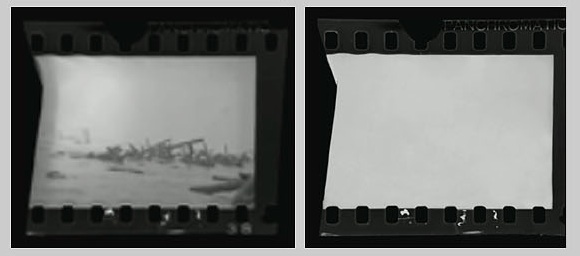
Robert Capa, forged “ruined” D-Day negative on right, original on left (3)
[Editor’s Note: When photographer Rob McElroy emailed me an earlier draft of what appears below, a quick comparison of two contact-print screenshots taken from the 2014 TIME video and sent to me by photographer Mike Doukas confirmed McElroy’s diagnosis. My thanks to McElroy for granting permission for its publication here.
It embarrasses me to admit that it never occurred to me to question the authenticity of what McElroy proves beyond question constitute crude forgeries of some of Capa’s purportedly damaged D-Day negatives. I’m particularly mortified because not only did both Ross Baughman and I devote considerable time and effort to analyzing these fakes, but I solicited commentary on them from a number of other professionals in the field.
However, the fact that I and my colleagues took their authenticity for granted also serves as an indicator of what can happen when reputable individuals and institutions perpetrate a fraud even as transparent as this one. All the principals — Time-Life, Magnum Photos, the International Center of Photography, and former LIFE picture editor John Morris — stand deeply implicated in a decades-long cover-up of Capa’s real actions and output on D-Day, of which this is the latest example. — A. D. C.]
•
The “Magnificent Nine” Faked by TIME
by Rob McElroy
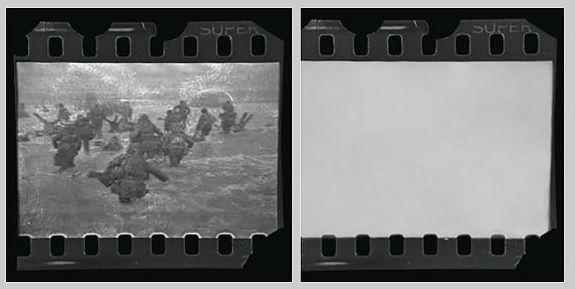
Robert Capa, forged “ruined” D-Day negative on right, original on left (1)
After watching TIME magazine’s online video detailing the story behind Robert Capa’s famous “Magnificent Eleven” photographs from D-Day, and reading the new theories and analyses put forth by photography critic A. D. Coleman and photographer J. Ross Baughman regarding the “ruined” negatives from that day, I became instantly intrigued by the mystery, and then suddenly alarmed.
As a professional photographer for the past 34 years, with a wealth of experience developing film, I could not explain why the “ruined” negatives shown in the video looked the way they did. Then, after carefully scrutinizing all the negatives shown in the video, I figured it out.
I had just discovered a journalistic no-no, a breach of trust, a total fraud. TIME had faked nine photographs in their documentary video and never explained to the viewer what they had done.
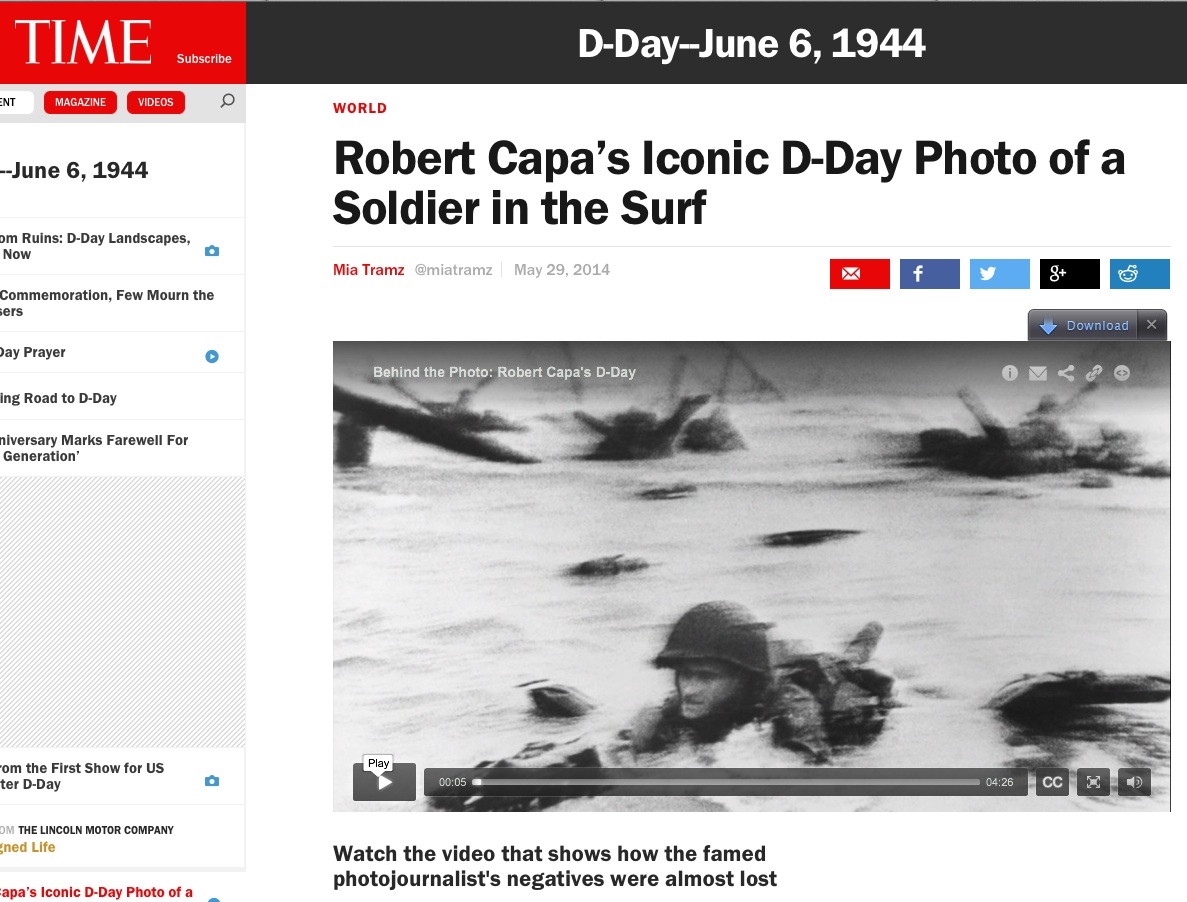
TIME, “Behind the Picture: Robert Capa’s D-Day” (2014) screenshot.
Posted on May 29, 2014 by TIME Associate Photo Editor Mia Tramz, the TIME video is entitled “Behind the Picture: Robert Capa’s D-Day,” and is narrated by LIFE‘s picture editor, John Morris, who was there, in LIFE‘s London office, on June 7, 1944, when the negatives were processed.
The video shows all of Capa’s original black & white negatives from June 6, 1944 (only nine of which have actually survived as original camera negatives), plus nine negatives that are purported to be some of the Capa negatives that were supposedly “ruined” during processing. Morris has always claimed that an overheated film-drying cabinet caused the emulsion to “run” (melt) on most of Capa’s four rolls of 35mm b&w film, rendering all but the “Magnificent Eleven” negatives useless.
The trouble is, the negatives TIME displayed in their video, which supposedly show some of the “ruined” Capa negatives, are totally faked. The overexposed-looking fake negatives appear completely opaque (all-white) and are a total fabrication — and nowhere in the video do the producers explain what they did, how they did it, or why.
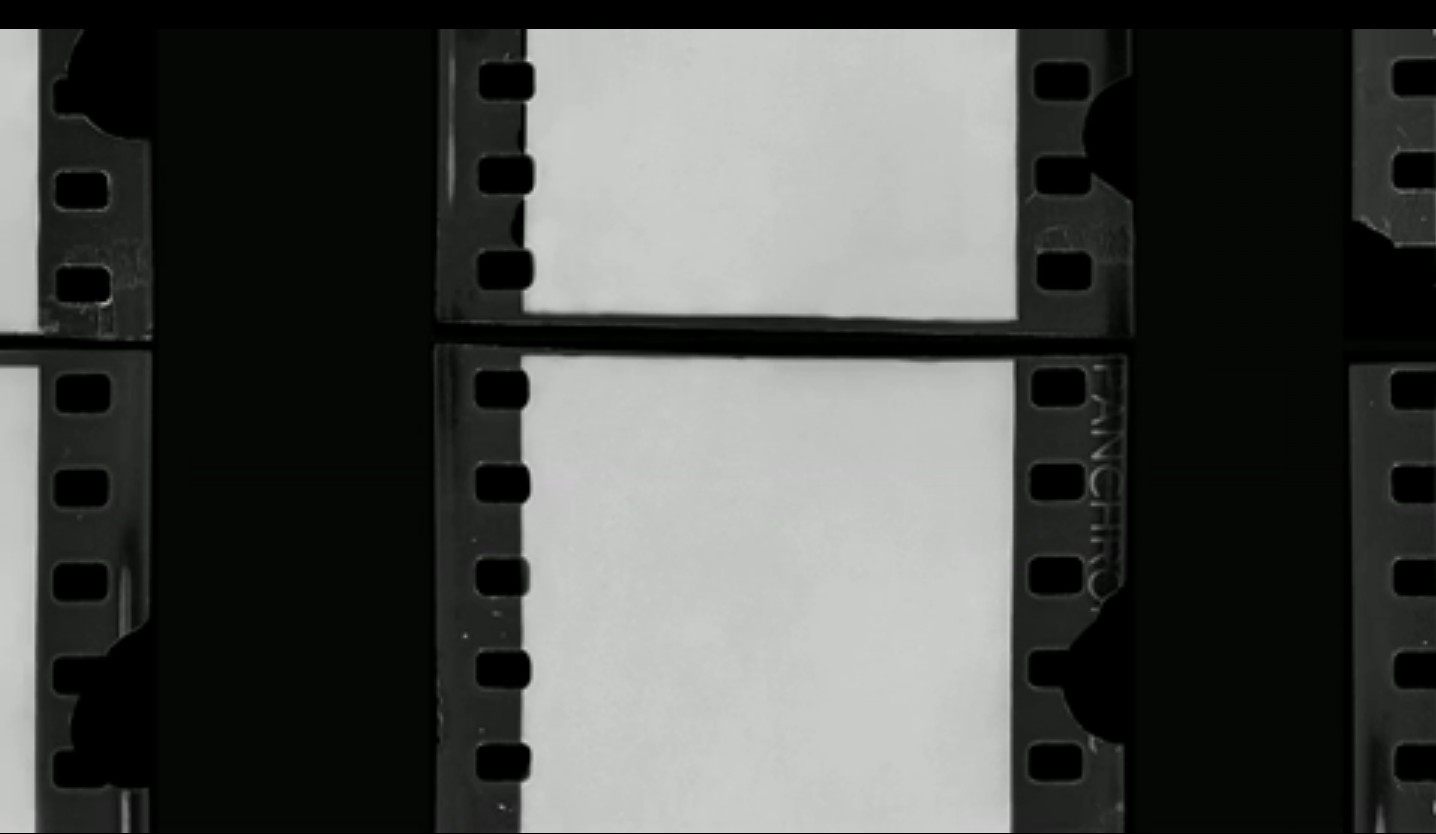
Robert Capa, “ruined” frames from D-Day, June 6, 1944. Courtesy Wikimedia Commons.
Through the filmmaker’s use of calculated and deceptive video editing, the viewer is flimflammed into believing that what they are seeing are nine of Capa’s original “ruined” negatives from 1944. In the video, Morris never specifically refers to these seemingly overexposed frames of all-white film that are being scrolled across the screen in front of the viewer. Instead, he simply tells the story of how the “emulsion ran” (melted) on most of the negatives, leading the viewer to believe that what they are seeing are some of the damaged negatives. As soon as Morris begins discussing the “Magnificent Eleven,” up pop Capa’s good images. (In Morris’s defense, he probably had no idea what visuals the producers would use — or, in this case, fake.)
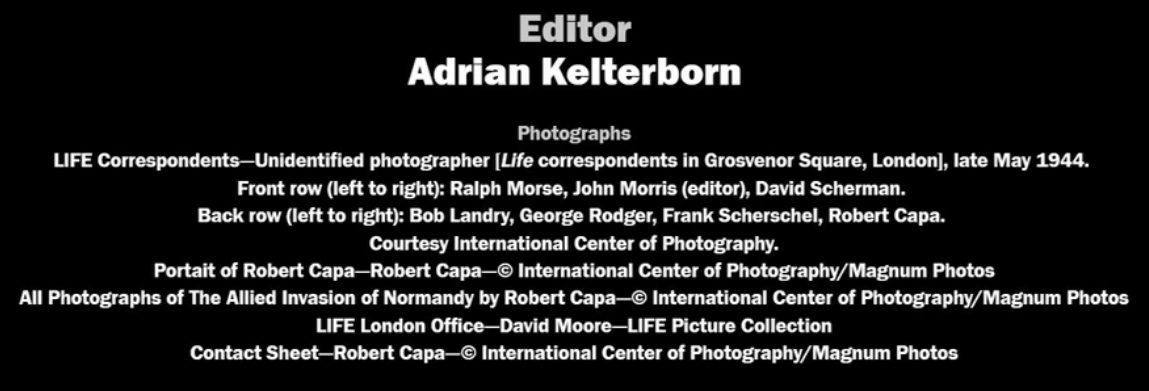
“Behind the Picture: Robert Capa’s D-Day,” 2014, credits.
Thus, Morris never claims that what we are seeing are some of Capa’s “ruined” negatives from June 6, 1944. We are just hoodwinked into thinking so, without even an explanation from the show’s editor/producer as to what they are showing on-screen at the time.
As a point of fact, Morris has stated more than once in the past that he wished he had saved the “ruined” negatives, but unfortunately he threw them out the day they were developed.
•

Robert Capa, fake D-DAY negatives from 2014 TIME video. Comparison screenshots and composite design by Rob McElroy.
Now for the evidence, which makes this video so deceitful. (You can click on the composite immediately above, and on the individual pairs of negatives above and below, to enlarge them. Note retouched-out negative numbers in forged negatives.)
If you carefully compare the edges of the individual frames of the nine extant Capa negatives (the ones showing Capa’s successful/good images) to the individual frames of the all-white, purportedly “ruined” negatives, you will immediately see they match exactly.
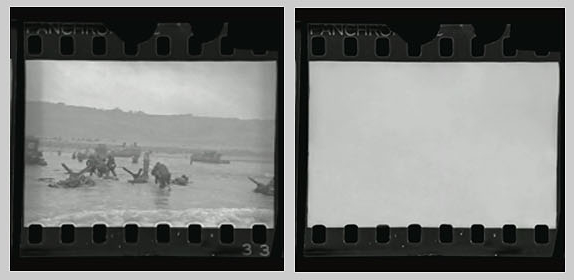
Robert Capa, forged “ruined” D-Day negative on right, original on left (2)
All of the edge punch marks, ripped sprocket holes, clipped corners, processing marks, Kodak edge-printing, etc. are identical on Capa’s good negatives when compared to these newly revealed fake negatives — with one glaring exception. Someone has removed (retouched out) all of the negative numbers on the fake negatives. Why would someone do that unless they were trying to be deceptive — hoping that no one would notice the similarities?
Whoever retouched out the negative numbers while concocting these fake Capa negatives also whited out the image areas on all of the negatives, to make them appear opaque. (It was the editor or producer’s attempt to make them look “melted,” I guess.)
It’s just bad journalism to me, although maybe I shouldn’t even call it journalism; suicide journalism might be a better term.
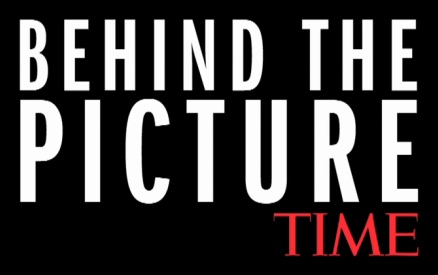 Whenever an organization, especially a respected journalistic organization, publishes fake pictures, and doesn’t disclose their trickery or the purpose for the deceit, their feet should be held to the fire and their deceptive flimflamming should be publicly exposed. It’s definitely a stain on TIME‘s reputation.
Whenever an organization, especially a respected journalistic organization, publishes fake pictures, and doesn’t disclose their trickery or the purpose for the deceit, their feet should be held to the fire and their deceptive flimflamming should be publicly exposed. It’s definitely a stain on TIME‘s reputation.
Also, whether intentionally (in order to prevent detection) or not, the video’s editor, Adrian Kelterborn, presented the fake negatives in reverse order (starting with frame 38 and going backwards) instead of the chronological order in which the successful Capa exposures were presented (the good negs in the video start with frame 28 and progress forward to frame 38). Kelterborn also presented the “ruined” negatives vertically on the screen instead of matching the horizontal orientation of the good negatives in the video, further disguising the fact that both sets of negatives (the good Capa images and the all-white fake images) are in fact the same negatives, with one set just duplicated and retouched to look “melted.”
If an educator could download the video and save it before it’s taken down, it would be a good journalism-class teaching tool for “What not to do” if you want to gain respect and credibility as a journalist.
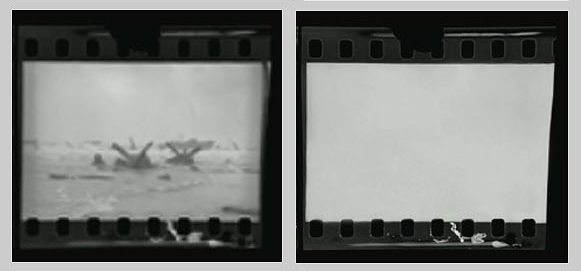
Robert Capa, forged “ruined” D-Day negative on right, original on left (4)
Deceitful, misleading journalism is one of my pet peeves, and even though the editor of this video probably thought there was no harm in dummying up some fake “melted” negatives, it is fundamentally wrong, and should never be tolerated, under any circumstances, by any credible news organization. If you want to illustrate something because you don’t have access to the original, then tell your viewers it’s an illustration. Don’t try to deceive them by removing the negative numbers and doctoring the original images.
Digital trickery has no place in a news organization.
•
(For an index of links to all posts in this series, click here.)
•
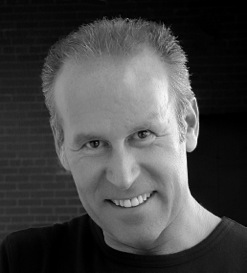
Rob McElroy
Based in Buffalo, NY, Rob McElroy has been a professional photographer since 1980, shooting primarily photojournalistic, commercial, advertising and magazine assignments. He has extensive experience and thrives on photographic challenges both technical and artistic. In his early years he honed his skills working full time for the Associated Press and shooting sports for the NFL, all the while continuing to shoot industrial, commercial and studio jobs to get experience in all of photography’s genres.
For the past 15 years, McElroy has turned his attention to mastering the art of the daguerreotype process, and he is one of only a handful of practicing daguerreotypists. For a Flickr portfolio of his daguerreotypes, click here. Click here for a 2009 interview with him about his daguerreian activities.
He’s also a photo historian, having researched and co-written two books on local photo history. His extensive photo-history library, along with his large study collection of early photographic materials, keeps him actively involved in photo-conservation research projects, often in collaboration with various institutions. To contact Rob McElroy, click here.
Guest Post 12: Rob McElroy on Robert Capa
Robert Capa, forged “ruined” D-Day negative on right, original on left (3)
[Editor’s Note: When photographer Rob McElroy emailed me an earlier draft of what appears below, a quick comparison of two contact-print screenshots taken from the 2014 TIME video and sent to me by photographer Mike Doukas confirmed McElroy’s diagnosis. My thanks to McElroy for granting permission for its publication here.
It embarrasses me to admit that it never occurred to me to question the authenticity of what McElroy proves beyond question constitute crude forgeries of some of Capa’s purportedly damaged D-Day negatives. I’m particularly mortified because not only did both Ross Baughman and I devote considerable time and effort to analyzing these fakes, but I solicited commentary on them from a number of other professionals in the field.
However, the fact that I and my colleagues took their authenticity for granted also serves as an indicator of what can happen when reputable individuals and institutions perpetrate a fraud even as transparent as this one. All the principals — Time-Life, Magnum Photos, the International Center of Photography, and former LIFE picture editor John Morris — stand deeply implicated in a decades-long cover-up of Capa’s real actions and output on D-Day, of which this is the latest example. — A. D. C.]
•
The “Magnificent Nine” Faked by TIME
by Rob McElroy
Robert Capa, forged “ruined” D-Day negative on right, original on left (1)
After watching TIME magazine’s online video detailing the story behind Robert Capa’s famous “Magnificent Eleven” photographs from D-Day, and reading the new theories and analyses put forth by photography critic A. D. Coleman and photographer J. Ross Baughman regarding the “ruined” negatives from that day, I became instantly intrigued by the mystery, and then suddenly alarmed.
As a professional photographer for the past 34 years, with a wealth of experience developing film, I could not explain why the “ruined” negatives shown in the video looked the way they did. Then, after carefully scrutinizing all the negatives shown in the video, I figured it out.
I had just discovered a journalistic no-no, a breach of trust, a total fraud. TIME had faked nine photographs in their documentary video and never explained to the viewer what they had done.
TIME, “Behind the Picture: Robert Capa’s D-Day” (2014) screenshot.
Posted on May 29, 2014 by TIME Associate Photo Editor Mia Tramz, the TIME video is entitled “Behind the Picture: Robert Capa’s D-Day,” and is narrated by LIFE‘s picture editor, John Morris, who was there, in LIFE‘s London office, on June 7, 1944, when the negatives were processed.
The video shows all of Capa’s original black & white negatives from June 6, 1944 (only nine of which have actually survived as original camera negatives), plus nine negatives that are purported to be some of the Capa negatives that were supposedly “ruined” during processing. Morris has always claimed that an overheated film-drying cabinet caused the emulsion to “run” (melt) on most of Capa’s four rolls of 35mm b&w film, rendering all but the “Magnificent Eleven” negatives useless.
The trouble is, the negatives TIME displayed in their video, which supposedly show some of the “ruined” Capa negatives, are totally faked. The overexposed-looking fake negatives appear completely opaque (all-white) and are a total fabrication — and nowhere in the video do the producers explain what they did, how they did it, or why.
Robert Capa, “ruined” frames from D-Day, June 6, 1944. Courtesy Wikimedia Commons.
Through the filmmaker’s use of calculated and deceptive video editing, the viewer is flimflammed into believing that what they are seeing are nine of Capa’s original “ruined” negatives from 1944. In the video, Morris never specifically refers to these seemingly overexposed frames of all-white film that are being scrolled across the screen in front of the viewer. Instead, he simply tells the story of how the “emulsion ran” (melted) on most of the negatives, leading the viewer to believe that what they are seeing are some of the damaged negatives. As soon as Morris begins discussing the “Magnificent Eleven,” up pop Capa’s good images. (In Morris’s defense, he probably had no idea what visuals the producers would use — or, in this case, fake.)
“Behind the Picture: Robert Capa’s D-Day,” 2014, credits.
Thus, Morris never claims that what we are seeing are some of Capa’s “ruined” negatives from June 6, 1944. We are just hoodwinked into thinking so, without even an explanation from the show’s editor/producer as to what they are showing on-screen at the time.
As a point of fact, Morris has stated more than once in the past that he wished he had saved the “ruined” negatives, but unfortunately he threw them out the day they were developed.
•
Robert Capa, fake D-DAY negatives from 2014 TIME video. Comparison screenshots and composite design by Rob McElroy.
Now for the evidence, which makes this video so deceitful. (You can click on the composite immediately above, and on the individual pairs of negatives above and below, to enlarge them. Note retouched-out negative numbers in forged negatives.)
If you carefully compare the edges of the individual frames of the nine extant Capa negatives (the ones showing Capa’s successful/good images) to the individual frames of the all-white, purportedly “ruined” negatives, you will immediately see they match exactly.
Robert Capa, forged “ruined” D-Day negative on right, original on left (2)
All of the edge punch marks, ripped sprocket holes, clipped corners, processing marks, Kodak edge-printing, etc. are identical on Capa’s good negatives when compared to these newly revealed fake negatives — with one glaring exception. Someone has removed (retouched out) all of the negative numbers on the fake negatives. Why would someone do that unless they were trying to be deceptive — hoping that no one would notice the similarities?
Whoever retouched out the negative numbers while concocting these fake Capa negatives also whited out the image areas on all of the negatives, to make them appear opaque. (It was the editor or producer’s attempt to make them look “melted,” I guess.)
It’s just bad journalism to me, although maybe I shouldn’t even call it journalism; suicide journalism might be a better term.
Also, whether intentionally (in order to prevent detection) or not, the video’s editor, Adrian Kelterborn, presented the fake negatives in reverse order (starting with frame 38 and going backwards) instead of the chronological order in which the successful Capa exposures were presented (the good negs in the video start with frame 28 and progress forward to frame 38). Kelterborn also presented the “ruined” negatives vertically on the screen instead of matching the horizontal orientation of the good negatives in the video, further disguising the fact that both sets of negatives (the good Capa images and the all-white fake images) are in fact the same negatives, with one set just duplicated and retouched to look “melted.”
If an educator could download the video and save it before it’s taken down, it would be a good journalism-class teaching tool for “What not to do” if you want to gain respect and credibility as a journalist.
Robert Capa, forged “ruined” D-Day negative on right, original on left (4)
Deceitful, misleading journalism is one of my pet peeves, and even though the editor of this video probably thought there was no harm in dummying up some fake “melted” negatives, it is fundamentally wrong, and should never be tolerated, under any circumstances, by any credible news organization. If you want to illustrate something because you don’t have access to the original, then tell your viewers it’s an illustration. Don’t try to deceive them by removing the negative numbers and doctoring the original images.
Digital trickery has no place in a news organization.
•
(For an index of links to all posts in this series, click here.)
•
Rob McElroy
Based in Buffalo, NY, Rob McElroy has been a professional photographer since 1980, shooting primarily photojournalistic, commercial, advertising and magazine assignments. He has extensive experience and thrives on photographic challenges both technical and artistic. In his early years he honed his skills working full time for the Associated Press and shooting sports for the NFL, all the while continuing to shoot industrial, commercial and studio jobs to get experience in all of photography’s genres.
For the past 15 years, McElroy has turned his attention to mastering the art of the daguerreotype process, and he is one of only a handful of practicing daguerreotypists. For a Flickr portfolio of his daguerreotypes, click here. Click here for a 2009 interview with him about his daguerreian activities.
He’s also a photo historian, having researched and co-written two books on local photo history. His extensive photo-history library, along with his large study collection of early photographic materials, keeps him actively involved in photo-conservation research projects, often in collaboration with various institutions. To contact Rob McElroy, click here.